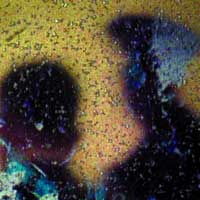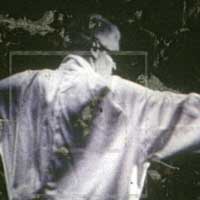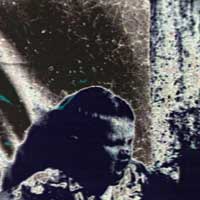Ian Andrews
Video
Departure: Transfigure, Australian Centre for the Moving Image, Melbourne, 8/12/2003 - 9/5/2004
IAN ANDREWS – DEPARTURE: catalogue essay
Rhys Graham
In digital video and design, the notion of layering is important to the way that many imaging software tools such as Photoshop and After Effects can be understood and used. As additional alterations are made to a moving or still image, these structures of information can be added in layers that can then be stripped back, deleted, or conjoined with other layers to create new, unforeseen effects. Prior to the use of these digital tools, Video artists seeking to manipulate and later a moving image used electronic tools which affected and manipulated the original source image. Many filmmakers on the other hand were able to use the surface of film itself as a skin upon which to work; to etch into, scratch or disfigure the image, or to strip back through chemicals or processing techniques. The natural decomposition of time added an additional layer of perception to the film form. In Departure, Ian Andrews has used digital techniques to evoke the decaying process that occurs to a film or photographic image over time, but in doing so, he has created an altogether different visual landscape in which different layers of image contest and compete against each other.
A small strip of archival domestic film of a man 'departing' loops endlessly back and forth, and as it does so, the repeated actions of the man seem to physically alter the layers, the skin of film and image through which we watch this action take place. The figure is marking out the landscape by traversing it, by exiting the frame and leaving a ghostly trace of his presence, but it is the surface of the visual form itself that is left marked.
In his video work, Andrews is interested in the way that the proliferation of images that flood our world leave traces and marks upon our vision and intelligence. In works such as The Harm Machine (1990), Jerking off the Troops (1992) and Data Panic (1998) the artist assembles found footage or overloaded images from the world around him into a clever critique of the way that we receive information and position ourselves within this visual landscape in the world. The Forgotten Memory Series of which Departure is a key work, is a meditative step back from this oversaturated world. In the three works that compose the series, Andrews allows the textures and forms of the image to overlay into an abstract landscape of frozen time. The filmmaker hovers over this looping strip of film like a scientist peering through a microscope. The footsteps and subtle physical shifts of this walking man become an enclosed world of meaning, without entry or exit, in which the memory and traces of this man's presence in the landscape form their own coherent and enclosed universe. It is the way that the image conceals and reveals him, in the flickering layers of colour, decomposition and fracture that reminds us of the skin that separates the viewer from this beautiful shimmering image. Yet, the very existence of these layers invites us to try and peel them back, to reach closer to this ghostly energetic presence and allow the surface of the image to make contact with the surface of our senses, intellect and emotions.
Forgotten Memories Series - Ian Andrews construction notes
Process
These three pieces represent the results of a process in which a collection of found film, including 1950s home movie footage, out-takes of an industrial film, out-takes from some of my own films, and some hand-painted and scratched film, were spliced into short loops, re-filmed and superimposed over each other.
After cutting the loops to various lengths the images were re-shot with a video camera. They were then processed with different devices and combined by a process known as non-additive mix. In video terms, a non-additive mix differs from the standard additive mix, or dissolve, in which the luminance value, or intensity, of the A and B image is mixed proportionally (E.g. 50%:50%, 60%:40%, etc.). A non-additive mix blends the lighter parts of one image into the darker parts of the other image in such a way that the full intensity of each image is maintained at 100%.
Some of the loops were also processed through a Michael Cox 'Cox Box' colour synthesizer and, in some instances, were combined with screen captured random video noise and computer animation. This process resulted in several hours of material from which the three pieces were selected.
The methodology of the production of these pieces was decidedly analogue. In one way it was a final attempt to fully utilise some of the old analogue broadcast video equipment that I had been collecting and restoring over the years (namely the Cox non-additive mix module that I had salvaged from an ancient and water damaged production switcher, the Cox Box and a downstream keyer unit).
The idea was to work fast, without the hindrance of too many options, and with the instantaneous hands on approach that real-time processing affords. I also wanted to allow some degree of randomness to enter the process (the results of which were to be final and not open to correction), and, at the same time, to capture the peculiarities of these old technologies. For this approach digital methods (of that time period and within my budget) were out of the question.
Working with found film permits me to work entirely within what Jean Louis Comolli describes as that which has been generally relegated to the 'unconscious of cinema': the editing, chemical processing, the black between frames, the sound image relationship and to extend video processing and digital media techniques. The working limits imposed by a 'cameraless' video practice establishes a certain freedom: a release from the conscious decision making of camerawork, direction, etc. The use of found home movie footage also allows me to work with, hat is ostensibly, the private recorded memories of others completely detached from my own or from public memory (history) in a sense, forgotten memories.
Although the works superficially resemble a video clip for three pieces of music, this was not the intention. Rather it was to create a series of electronic/chemical/optical moving paintings that also contained the added dimension of sound. It is, in a sense, an extension of certain process based minimalist musical compositions, yet the work is not concerned so much with the foregrounding of filmic representation as such, which was the focus of the structural-materialist filmmakers of the 1960s and 70s.Soundtrack I have tried to break down the opposition between, on the one hand, music that builds, and on the other hand, music that seems to go nowhere. I have tried to incorporate both aspects, to achieve this quality of nowhereness, or equilibrium (steady state), while at the same time, allowing a subtle under play of slowly building textures and tensions. The music is minimal and of modular construction in which a diverse range of background elements revolve around an empty centre: clicks, pops and crackles; short one note (or one chord) samples from easy listening records such as skating rink and theatrical organ records; tight jabs of sound over reverberating tones and asymmetrical basslines.
Part 1: Jumpcut
Two pieces of found footage were used to produce Jumpcut: a series of frames cut from the head and tails of various takes of a talking head shot for a 1970s industrial film or commercial; and a piece of 1950s/60s home movie footage depicting a jumping child interrupted by the perforation marks at the end of the reel. Both images are processed through the Cox Box. The loop of the jumping boy had developed, over time, a network of miniscule cracks in the emulsion which were further emphasised by the increased contrast of the processing and the slow motion.
Part 2: Equalibrium
One of the layers of this piece consists of an image of a Sufi like spinning dancer in a white lab coat. This out-take from an earlier film, Phonogramme, had somehow become splattered with a kind of mould that formed small flower like shapes in the frame. It is combined with a loop of hand-painted film which deteriorates slowly each time the loop repeats. The accidental misspelling of the title was retained as a piece of word play.
Part 3: Departure 9:20
Departure examines a single moment expanded in duration and repeated. The loop depicts a rather banal scene: a man walks past a small and informal gathering of people. There seems to be a photographer and an official of some sort, yet the reason for the man's journey is missing. If the shot had been allowed to continue we would have seen the aeroplane that the man was attempting to board, waiting on the tarmac. This cut, the removal of one of the most important narrative elements in the shot, allows its meaning to drift into ambiguity. The shot becomes a blank slate, or an open text. Each time the loop repeats it becomes possible to inject new meaning, Nothing is determined and the central figure remains anonymous. Throughout the succession of loops the image of the central figure drifts in and out of focus. Our view tracks around within the frame of the original footage, as a result of the re-filming, so that the distinction between the original camera movements and those added later in the process becomes difficult. Here the distinction between figure and ground breaks down. The establishing data of the shot fails to emerge from the hazy blank background so that the figures float in an indeterminate semiotic field. What then comes to foreground is the grain: the physicality of the material substrate. But, unlike the self-reflexive strategies of structural/materialist filmmaking and minimalism, these material artifacts are not permitted to dominate the piece to the exclusion of all other content, but instead, interact with the iconic elements in a undecidable and uncanny oscillating movement. The grain is further emphasised by the superimposition of additional layers: a loop of handpainted film (composed of ink, salt and dirt) which slowly disintegrates each time it repeats; and an intermittent layer of random video noise. Both create a patina of noise particles (optical and electronic).


